Influence of ICCGHAZ on the Low-Temperature Toughness in HAZ of Heavy-Wall X80 Pipeline Steel
Abstract
:1. Introduction
2. Materials and Methods
2.1. Materials and Welding Processes
2.2. Impact Toughness Test and Fractography Analysis
2.3. Microstructural Characterization
3. Results and Discussion
3.1. Microstructure
3.2. Impact Toughness and Fractography Characterization
3.3. The Brittle Crack Initiation Analysis
3.4. The Influence Mechanism of ICCGHAZ on HAZ at Low Temperature
4. Conclusions
- (1)
- The influence of ICCGHAZ on the overall toughness is temperature-dependent. At temperatures higher than −45 °C, the toughness of ICCGHAZ decreases to a limited extent and will not result in embrittlement. Only at temperatures below −45 °C does ICCGHAZ play an obvious role in decreasing the overall toughness. For pipelines serving below −45 °C, influence of ICCGHAZ on low temperature toughness of the whole weld joint should be considered.
- (2)
- The influence of ICCGHAZ is particularly associated with its microstructure. The MA constituent in ICCGHAZ is larger in size, higher in fraction, and more likely to form necklace-like distribution on PAGB. These characteristics contributes to MA as a potential site of brittle initiation.
- (3)
- The embrittlement mechanism of ICCGHAZ is associated with the three stages of cleavage fracture formation, which are related to the characteristic of MA constituent and temperature. At extremely low temperatures (below −45 °C), the fracture is nucleation-controlled. Single and small MA constituents can initiate a brittle crack. Once it nucleates, the second particle/matrix interface and the PAGB cannot hinder the propagation. The brittle crack initiation sites can be located in either ICCGHAZ or CGHAZ; at moderately low temperatures (−45~0 °C), the MA constituent with large size or close distribution meets the cleavage crack initiation and propagation conditions. The initiation sites are preferentially located in ICCGHAZ and are propagation-controlled. Due to the large stable crack propagation energy, the sample will not present embrittlement. At higher temperatures (0~20 °C), the fracture is ductile, and the overall HAZ has excellent toughness.
Author Contributions
Funding
Institutional Review Board Statement
Informed Consent Statement
Data Availability Statement
Acknowledgments
Conflicts of Interest
References
- Gautier, D.; Bird, K.J.; Charpentier, R.R.; Grantz, A.; Houseknecht, D.W.; Klett, T.R.; Moore, T.E.; Pitman, J.K.; Schenk, C.J.; Schuenemeyer, J.H.; et al. Assessment of undiscovered oil and gas in the Arctic. Science 2009, 324, 1175–1179. [Google Scholar] [CrossRef] [Green Version]
- Hart, A. A review of technologies for transporting heavy crude oil and bitumen via pipelines. J. Pet. Explor Prod. Technol. 2014, 4, 327–336. [Google Scholar] [CrossRef] [Green Version]
- Horn, A.M.; Hauge, M. Material challenges for arctic offshore applications, a reliability study of fracture of a welded steel plate based on material toughness data at −60 °C. In Proceedings of the 2011 International Offshore and Polar Engineering Conference, Maui, HI, USA, 19–24 June 2011. [Google Scholar]
- Orlov, V.V.; Malyshevskii, V.A.; Khlusova, E.I.; Golosienko, S.A. Production technology for arctic pipeline and marine steel. Steel Transl. 2014, 44, 696–705. [Google Scholar] [CrossRef]
- Kruglova, A.A.; Orlov, V.V.; Sych, O.V.; Khlusova, E.I. Improvement of chemical composition and production regimes for manufacture of K65–K70 (X80–X90) strip based on simulation. Metallurgist 2013, 57, 113–122. [Google Scholar] [CrossRef]
- Kiura, H.; Ishikawa, N.; Shimamura, J.; Nagao, R.; Kakihara, S.; Kondo, J. Development of Grade X80 Heavy gauge Linepipe for Extremely Low Temperature Service. In Proceedings of the 2015 International Ocean and Polar Engineering Conference, Big Island, HI, USA, 21 June 2015. [Google Scholar]
- Wang, X.Q.; Guo, Y.; Zhao, J.H.; Wang, G.D. Microstructure and Strengthening/Toughening Mechanisms of Heavy Gauge Pipeline Steel Processed by Ultrafast Cooling. Metals 2020, 10, 1323. [Google Scholar] [CrossRef]
- Shin, S.Y.; Oh, K.; Kang, K.B.; Lee, S. Improvement of Charpy impact properties in heat affected zones of API X80 pipeline steels containing complex oxides. Mater. Sci. Technol. 2010, 26, 1049–1058. [Google Scholar] [CrossRef]
- Akselsen, O.M.; Ren, X.; Nyhus, B.; Alvaro, A. Properties in Submerged Arc Welding of X80 Plate for Arctic Applications. In Proceedings of the 2015 International Ocean and Polar Engineering Conference, Big Island, HI, USA, 21 June 2015. [Google Scholar]
- Bhadeshia, H.K.D.H. Local brittle zones and the role of Niobium. Mater. Sci. Forum 2014, 783, 2129–2135. [Google Scholar] [CrossRef] [Green Version]
- Moeinifar, S.; Kokabi, A.H.; Hosseini, H.R.M. Effect of tandem submerged arc welding process and parameters of Gleeble simulator thermal cycles on properties of the intercritically reheated heat affected zone. Mater. Des. 2011, 32, 869–876. [Google Scholar] [CrossRef]
- Andia, J.L.M.; Souza, L.F.G.; Bott, I.S. Microstructural and mechanical properties of the intercritically reheated coarse grained heat affected zone (ICCGHAZ) of an API 5L X80 pipeline steel. Mater. Sci. Forum 2014, 783, 657–662. [Google Scholar] [CrossRef]
- Huda, N.; Midawi, A.R.H.; Gianetto, J.; Lazor, R.; Gerlich, A.P. Influence of martensite-austenite (MA) on impact toughness of X80 line pipe steels. Mater. Sci. Eng. A 2016, 662, 481–491. [Google Scholar] [CrossRef]
- Li, X.D.; Fan, Y.; Ma, X.P.; Subramanian, S.; Shang, C. Influence of Martensite-Austenite constituent formed at different intercritical temperatures on toughness. Mater. Des. 2015, 67, 457–463. [Google Scholar] [CrossRef]
- Bovanenkovo-Ukhta and Bovanenkovo-Ukhta 2 Gas Transmission from the Yamal Peninsula into Russia’s Unified Gas Supply System. Available online: http://www.gazprom.com/projects/Bovanenkovo-ukhta (accessed on 20 November 2021).
- Amar, K.D.; John, G.S.; David, K.M. Color tint-etching for multiphase steels. Adv. Mater. Process. 2003, 161, 27–30. [Google Scholar]
- Lepera, F.S. Improved etching technique for the determination of percent martensite in high-strength dual-phase steels. Metallography 1979, 12, 263–268. [Google Scholar] [CrossRef]
- Shin, S.Y. Effects of Microstructure on Tensile, Charpy Impact, and Crack Tip Opening Displacement Properties of Two API X80 Pipeline Steels. Metall. Mater. Trans. A 2013, 44, 2613–2624. [Google Scholar] [CrossRef]
- Li, X.D.; Ma, X.P.; Subramanian, S.V.; Misra, R.D.K.; Shang, C. Structure–Property–Fracture Mechanism Correlation in Heat-Affected Zone of X100 Ferrite−Bainite Pipeline Steel. Metall. Mater. Trans. E 2015, 2, 1–11. [Google Scholar] [CrossRef] [Green Version]
- Bonnevie, E.; Ferrière, G.; Ikhlef, A.; Kaplan, D.; Orain, J.M. Morphological aspects of martensite–austenite constituent in intercritical and coarse grain heat affected zones of structural steels. Mater. Sci. Eng. A 2004, 385, 352–358. [Google Scholar] [CrossRef]
- Kim, I.; Nam, H.; Lee, M.; Nam, D.; Park, Y.; Kang, N. Effect of martensite–austenite constituent on low-temperature toughness in YS 500 MPa grade steel welds. Metals 2018, 8, 638. [Google Scholar] [CrossRef] [Green Version]
- Tong, L.W.; Niu, L.C.; Jing, S.; Ai, L.; Zhao, X.-L. Low temperature impact toughness of high strength structural steel. Thin Wall Struct. 2018, 132, 410–420. [Google Scholar] [CrossRef]
- Wan, Q.M.; Wang, R.S.; Shu, G.G.; Ding, H.; Huang, P.; Lv, F.; Weng, L.-K. Analysis method of Charpy V-notch impact data before and after electron beam welding reconstitution. Nucl. Eng. Des. 2011, 241, 459–463. [Google Scholar] [CrossRef]
- Chen, J.H.; Cao, R. Micromechanism of Cleavage Fracture of Metals, 1st ed.; Butterworth-Heinemann: Oxford, UK, 2015; pp. 81–140. [Google Scholar] [CrossRef]
- Lambert, P.A.; Gourgues, A.F.; Besson, J.; Sturel, T.; Pineau, A. Mechanisms and modeling of cleavage fracture in simulated heat-affected zone microstructures of a high-strength low alloy steel. Metall. Mater. Trans. A 2004, 35, 1039–1053. [Google Scholar] [CrossRef]
- Li, Y.; Baker, T.N. Effect of morphology of martensite–austenite phase on fracture of weld heat affected zone in vanadium and niobium microalloyed steels. Mater. Sci. Technol. 2013, 26, 1029–1040. [Google Scholar] [CrossRef] [Green Version]
- Davis, C.l.; King, J.E. Effect of cooling rate on intercritically reheated micro structure and toughness in high strength low alloy steel. Mater. Sci. Technol. 1993, 9, 8–15. [Google Scholar] [CrossRef]
- Mohseni, P.; Solberg, J.K.; Karlsen, M.; Akselsen, O.M.; Østby, E. Cleavage fracture initiation at M–A constituent in intercritically coarse-grained heat-affected zone of a HSLA steel. Metall. Mater. Trans. A 2014, 45, 384–394. [Google Scholar] [CrossRef]
- Griffiths, J.R.; Owen, D.R.J. An elastic-plastic stress analysis for a notched bar in plane strain bending. J. Mech. Phys. Solids 1971, 19, 419–431. [Google Scholar] [CrossRef]
- Chen, J.H.; Wang, G.Z. Study of mechanism of cleavage fracture at low temperature. Metall. Mater. Trans. A 1992, 23, 509–517. [Google Scholar] [CrossRef]
- You, Y.; Shang, C.J.; Nie, W.J.; Subramanian, S. Investigation on the microstructure and toughness of coarse grained heat affected zone in X-100 multi-phase pipeline steel with high Nb content. Mater. Sci. Eng. A 2012, 558, 692–701. [Google Scholar] [CrossRef]
- Zhao, J.; Hu, W.; Wang, X.; Kang, J.; Yuan, G.; Di, H.; Misra, R. Effect of microstructure on the crack propagation behavior of microalloyed 560MPa (X80) strip during ultra-fast cooling. Mater. Sci. Eng. A 2016, 666, 214–224. [Google Scholar] [CrossRef]
- Pyshmintsev, I.Y.; Struin, A.O.; Gervasyev, A.M.; Lobanov, M.L.; Rusakov, G.M.; Danilov, S.V.; Arabey, A.B. Effect of Bainite Crystallographic Texture on Failure of Pipe Steel Sheets Made by Controlled Thermomechanical Treatment. Metallurgist 2016, 60, 405–412. [Google Scholar] [CrossRef]
- Echeverrıa, A.; Rodriguez-Ibabe, J.M. The role of grain size in brittle particle induced fracture of steels. Metall. Mater. Trans. A 2003, 346, 149–158. [Google Scholar] [CrossRef]
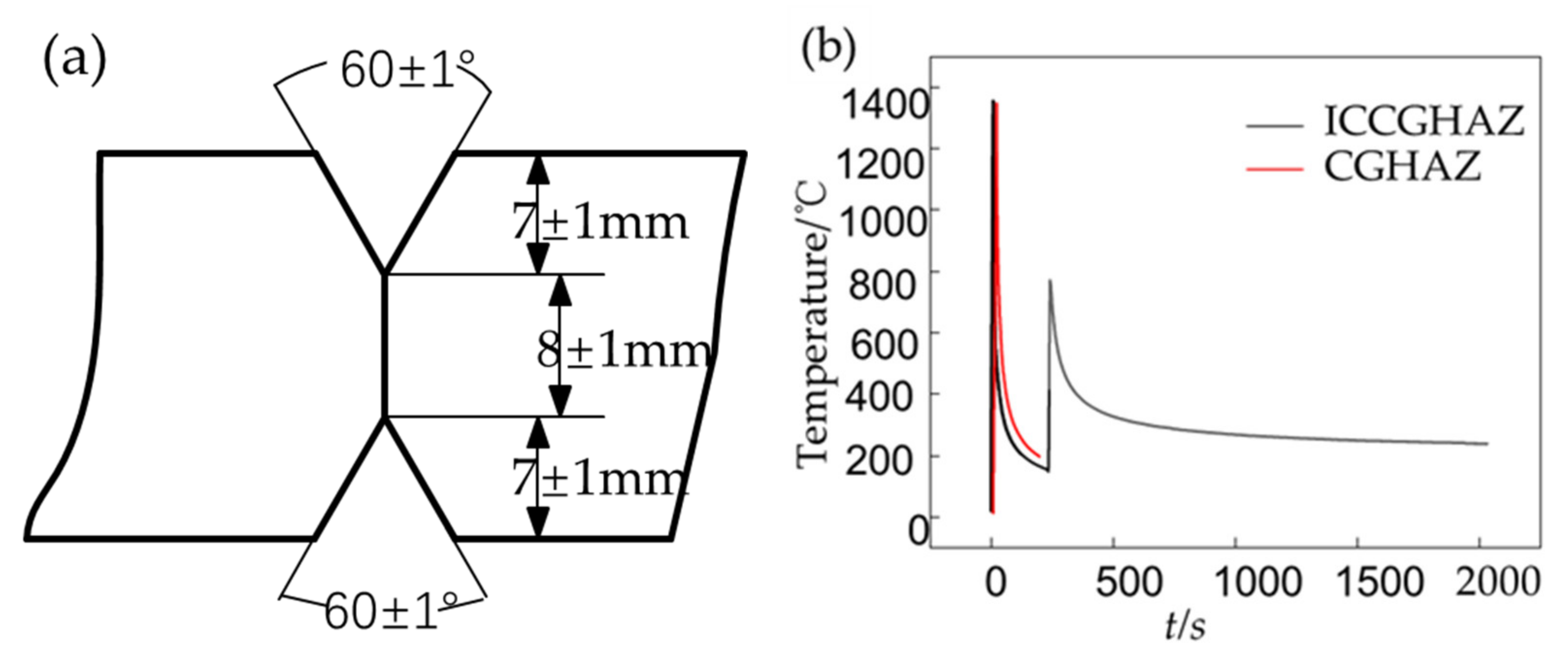


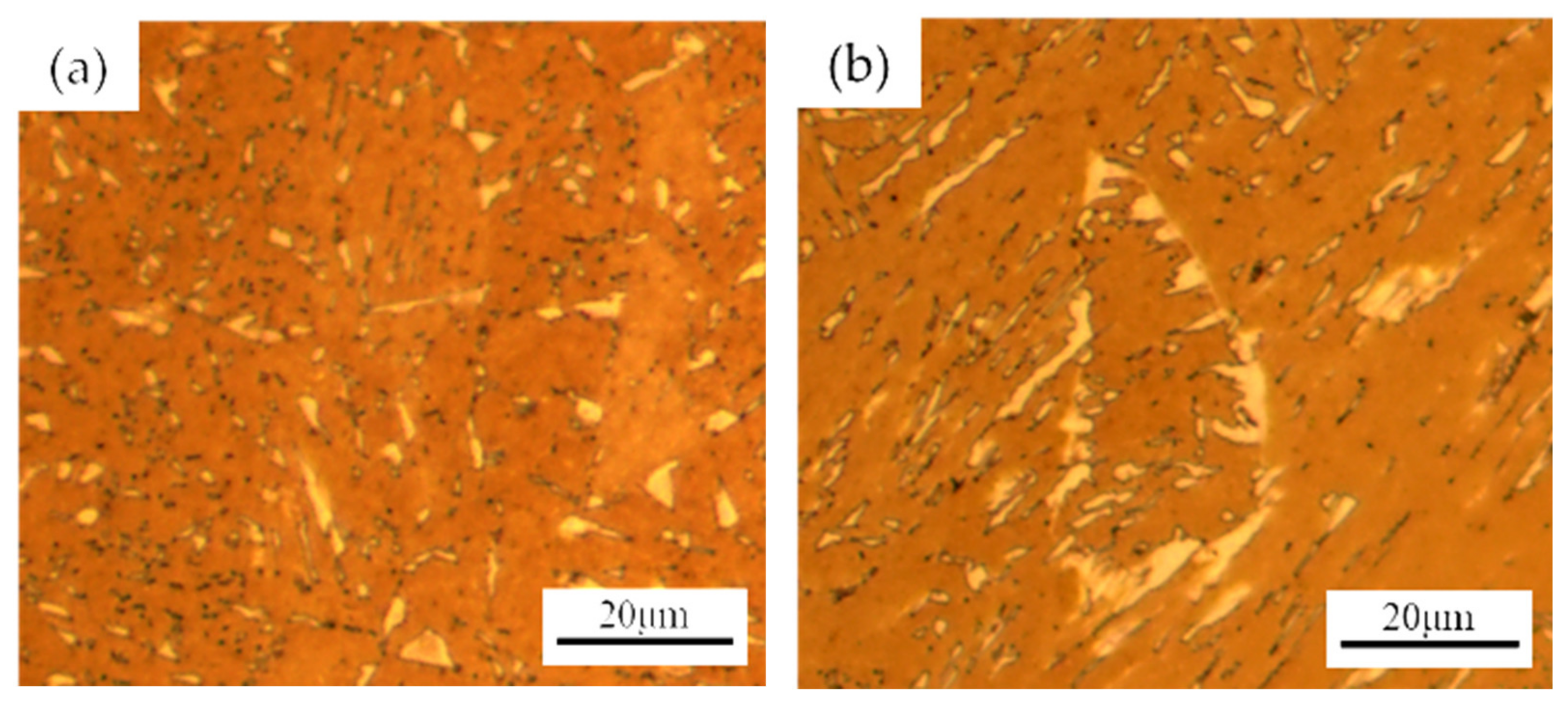
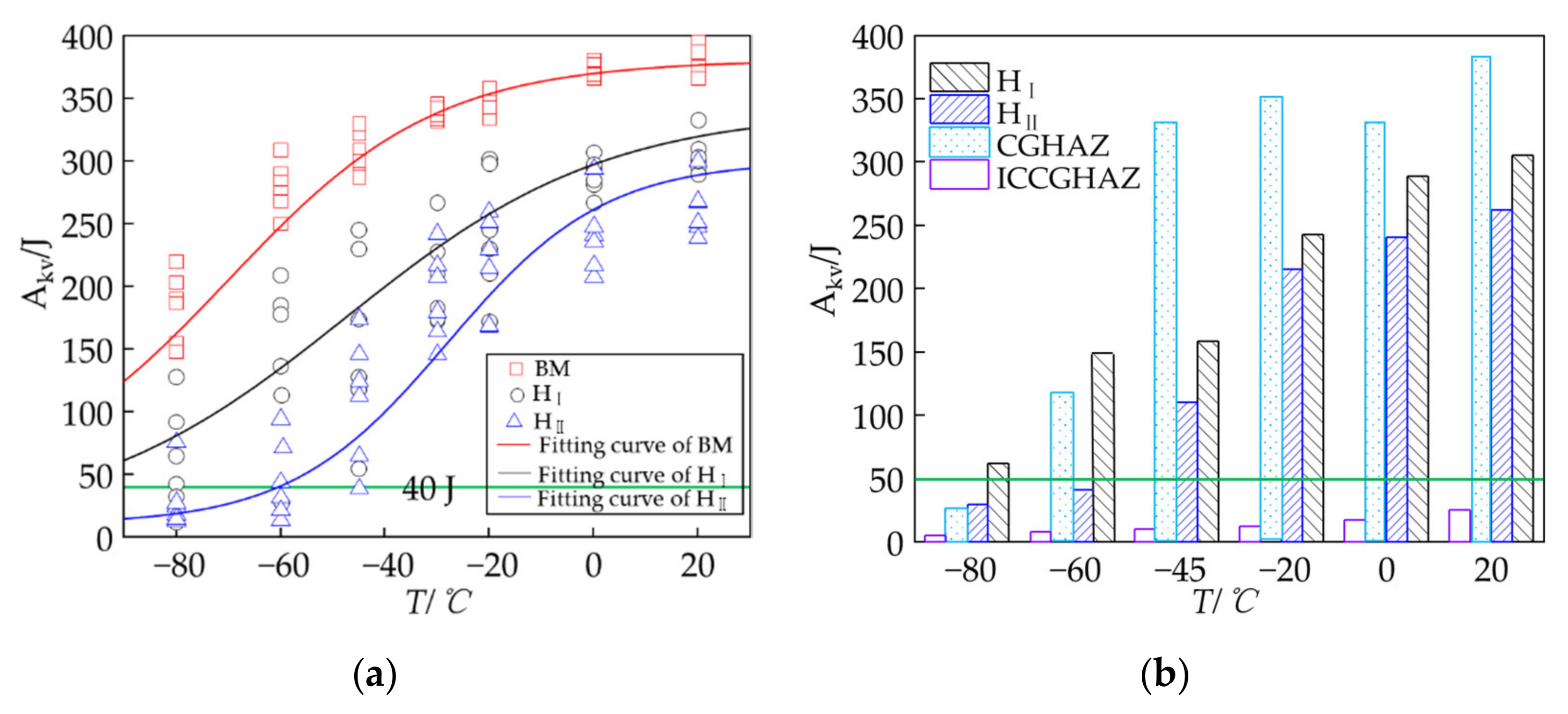



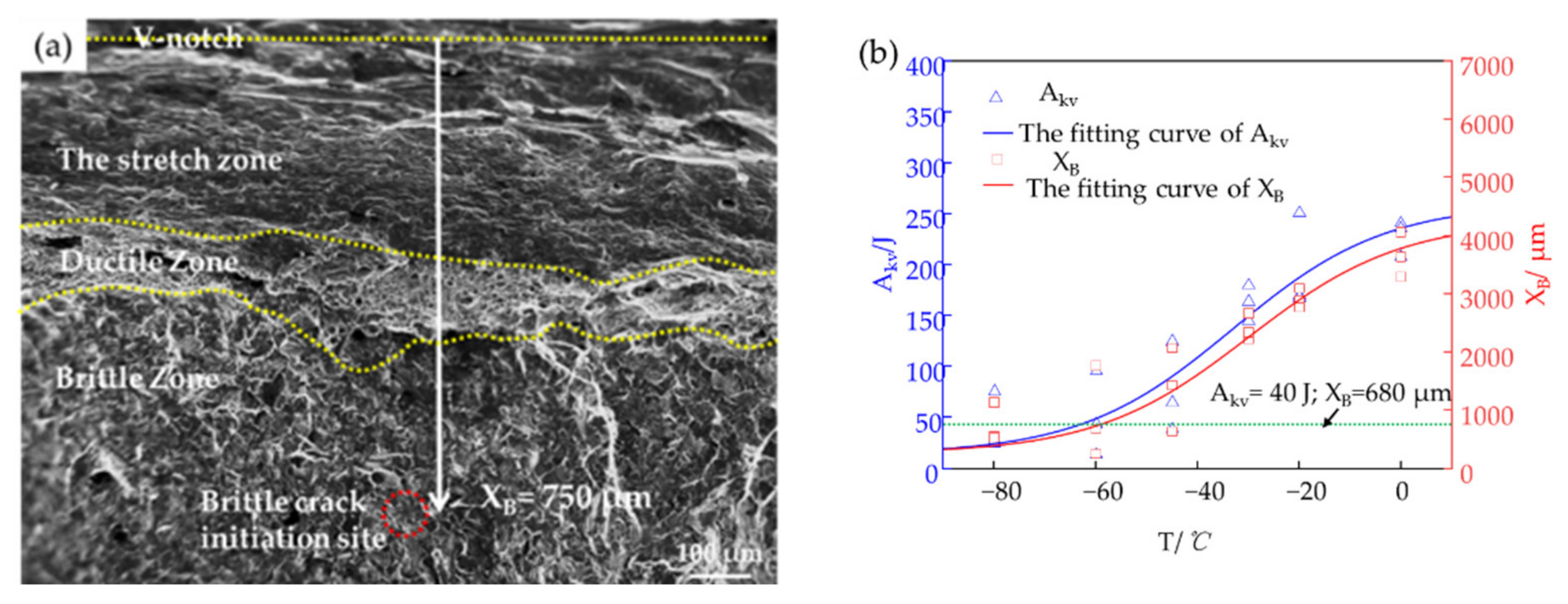
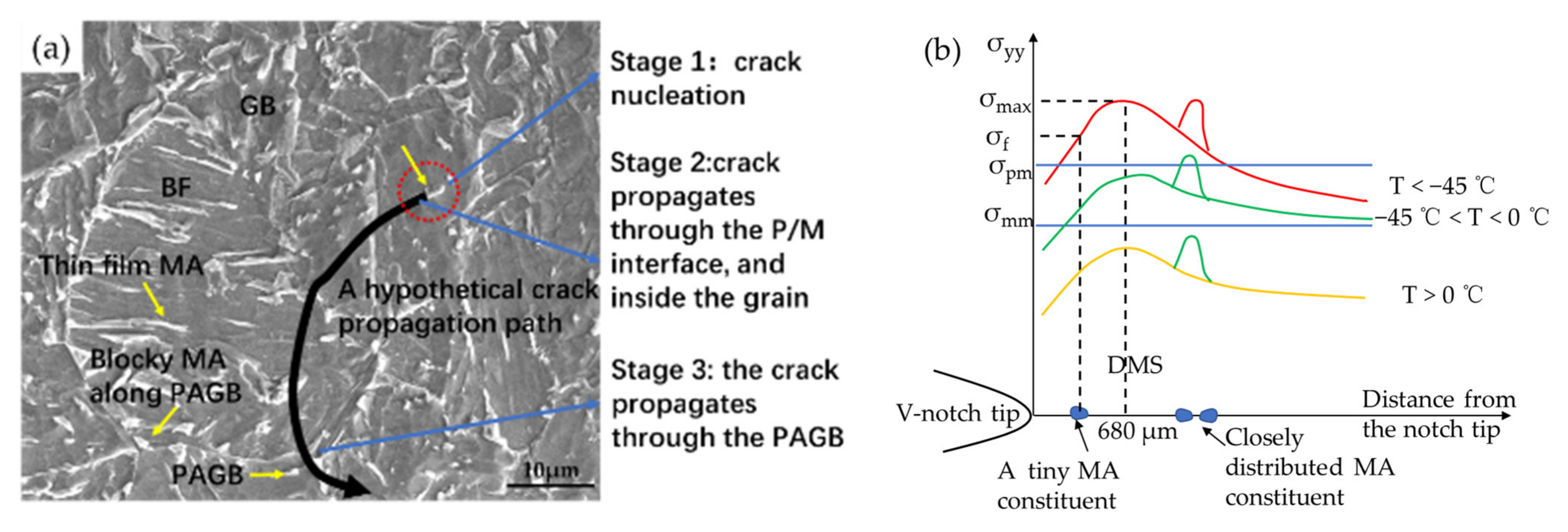
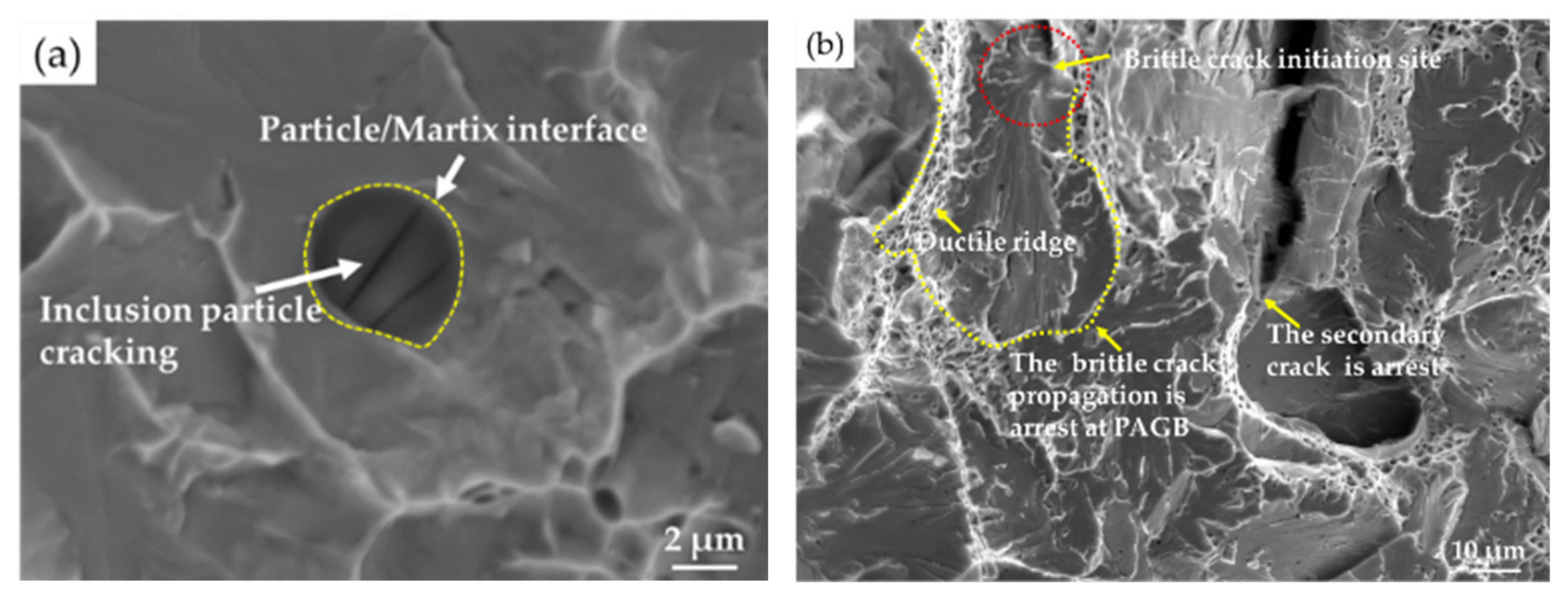
| C | Si | Mn | Cr | Ni | Mo | Nb + V + Ti |
|---|---|---|---|---|---|---|
| 0.03 | 0.19 | 1.63 | 0.23 | 0.14 | 0.23 | 0.11 |
| Welding Process | Current/A | Voltage/V | Speed/ cm/S | Heat input/ kJ/cm | |
|---|---|---|---|---|---|
| Inside welding | 1# wire | 1450 | 32 | 2.33 | 30 |
| 2#wire | 700 | 37 | |||
| Outside welding | 1# wire | 1500 | 33 | 2.33 | 35 |
| 2#wire | 750 | 38 | |||
| Positions | Upper Shelf Energy/J | Lower Shelf Energy/J | DBTT/°C |
|---|---|---|---|
| Base Metal | 390 | 50 | −78.5 |
| HI | 350 | 12 | −47.5 |
| HII | 300 | 9 | −28 |
| Higher than −45 °C | −45 °C | Below −45 °C | |
|---|---|---|---|
| The influence on Akv values | No brittle sample | Beginning of embrittlement | Most brittle samples |
| Crack initiation sites | Closely distributed or large size MA constituent | Both | Single and small MA constituent |
| Location of initiation sites | ICCGHAZ | ICCGHAZ, sometimes in CGHAZ | ICCGHAZ or CGHAZ |
| Cleavage fracture modes | Propagation control | Nucleation or propagation control | Nucleation control |
Publisher’s Note: MDPI stays neutral with regard to jurisdictional claims in published maps and institutional affiliations. |
© 2022 by the authors. Licensee MDPI, Basel, Switzerland. This article is an open access article distributed under the terms and conditions of the Creative Commons Attribution (CC BY) license (https://creativecommons.org/licenses/by/4.0/).
Share and Cite
Fu, C.; Li, X.; Li, H.; Han, T.; Han, B.; Wang, Y. Influence of ICCGHAZ on the Low-Temperature Toughness in HAZ of Heavy-Wall X80 Pipeline Steel. Metals 2022, 12, 907. https://doi.org/10.3390/met12060907
Fu C, Li X, Li H, Han T, Han B, Wang Y. Influence of ICCGHAZ on the Low-Temperature Toughness in HAZ of Heavy-Wall X80 Pipeline Steel. Metals. 2022; 12(6):907. https://doi.org/10.3390/met12060907
Chicago/Turabian StyleFu, Chao, Xueda Li, Haichuan Li, Tao Han, Bin Han, and Yong Wang. 2022. "Influence of ICCGHAZ on the Low-Temperature Toughness in HAZ of Heavy-Wall X80 Pipeline Steel" Metals 12, no. 6: 907. https://doi.org/10.3390/met12060907







